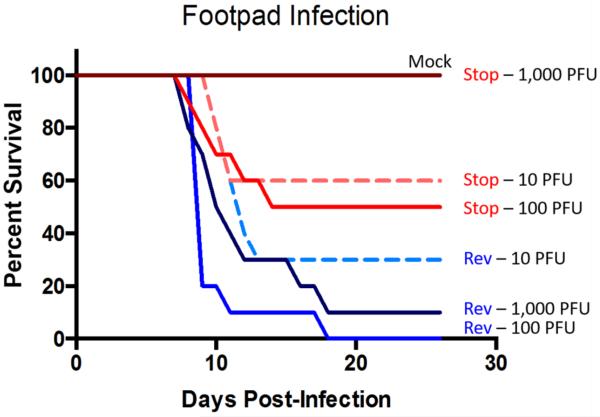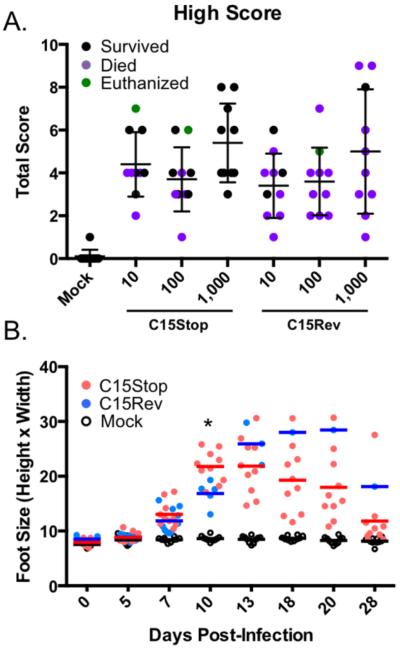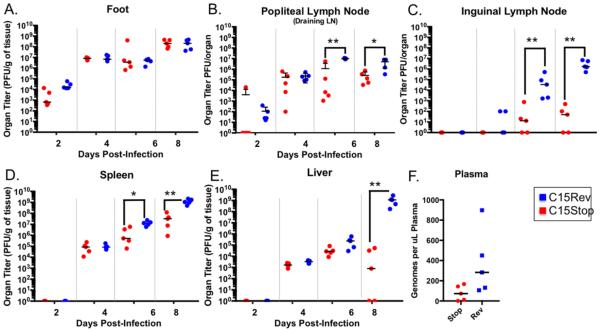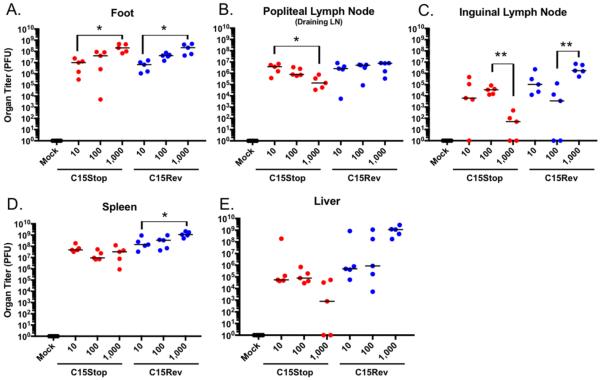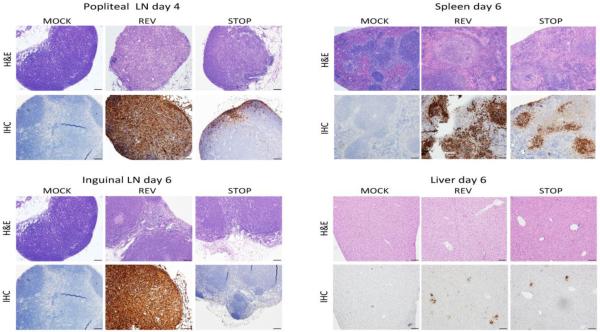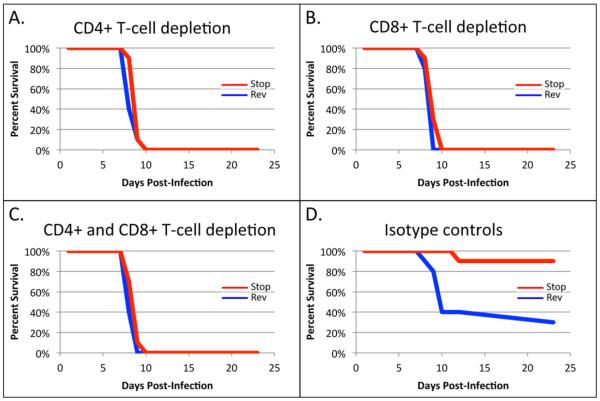Abstract
Most poxviruses encode a homolog of ~200,000-kDa membrane protein originally identified in variola virus. We investigated the importance of the ectromelia virus (ECTV) homolog C15 in a natural infection model. In cultured mouse cells, the replication of a mutant virus with stop codons near the N-terminus (ECTV-C15Stop) was indistinguishable from a control virus (ECTV-C15Rev). However, for a range of doses injected into the footpads of BALB/c mice there was less mortality with the mutant. Similar virus loads were present at the site of infection with mutant or control virus whereas there was less ECTV-C15Stop in popliteal and inguinal lymph nodes, spleen and liver indicating decreased virus spread and replication. The latter results were supported by immunohistochemical analyses. Decreased spread was evidently due to immune modulatory activity of C15, rather than to an intrinsic viral function, as the survival of infected mice depended on CD4+ and CD8+ T cells.
Keywords: poxvirus, viral pathogenicity, host defense, innate immunity, T cells, ectromelia virus
1. Introduction
Poxviruses are large double-stranded DNA viruses that infect a wide variety of hosts. Within the chordopoxvirus subfamily are two obligate human viruses (Damon, 2013): molluscum contagiosum virus, which causes a localized skin disease in young children and more extensive lesions in immunodeficient individuals and variola virus (VARV), the causative agent of smallpox and a member of the orthopoxvirus (OPXV) genus. Other OPXVs can infect humans including vaccinia virus (VACV) deployed as the smallpox vaccine and both cowpox virus (CPXV) and monkeypox virus (MPXV), which cause zoonoses. Host range can be broad as in the case of CPXV, which infects voles, mice, cats, elephants and humans, or very limited as for VARV in humans, camelpox virus in camels and ectromelia virus (ECTV) in mice (Damon, 2013; Pauli et al., 2010).
ECTV, the causative agent of mousepox, is unique among OPXVs because it is the only virus extensively studied in a natural host: the laboratory mouse (Esteban and Buller, 2005; Fenner, 1949b; Marchal, 1930). Mousepox has emerged as a valuable model for the study of OPXV pathogenicity as it causes a well-characterized smallpox-like disease (Buller et al., 2004; Schriewer et al., 2004). Mouse genetic components that influence susceptibility to mousepox have been identified and an early and strong type 1 immune response is key for survival (Chaudhri et al., 2004; Esteban and Buller, 2005).
Poxvirus genomes are organized with conserved, essential genes located centrally while more variable genes, often involved in host range determination and virus-host interactions, are located near the ends (Moss, 2013). Many of these viral immune modulators have been studied during VACV infection revealing a wealth of information about their roles (Smith et al., 2013); however, the matched ECTV/mouse model provides the opportunity to study these proteins in the context of a natural infection. One putative immune modulator is the VARV B22 protein and its homologs found in representatives of most chordopoxviruses (parapoxviruses are the exception) and all OPXV except VACV. The presence of orthologs in salmon gill poxvirus, the deepest member of the chordopoxvirus subfamily indicates that the gene was acquired early in poxvirus evolution (Gjessing et al., 2015). The presence of multiple copies in some poxviruses and extensive sequence divergence between genera are consistent with a long evolutionary history and host adaptation. The B22 family is also notable for comprising the largest size poxvirus proteins. The gene encoding the CPXV homolog of the B22 protein (CPXV219) is located near the right end of the genome and encodes a protein of 1,919 amino acids. The protein is expressed early in infection, has a signal peptide and transits the secretory pathway where extensive glycosylation and proteolytic cleavage occur prior to insertion into the plasma membrane (Reynolds and Moss, 2015). The MPXV homolog (MPXV197) has similar properties (Alzhanova et al., 2014). The roles of CPX219 and MPXV197 have been studied in mice and rhesus macaques, respectively. In mice, the absence of CPXV219 does not influence CPXV pathogenesis in a standard inbred strain as well as one highly susceptible to OPXV infections (Reynolds and Moss, 2015). Although MPXV primarily infects African rodents, the absence of MPXV197 results in a milder disease with accelerated T cell responses and less T cell dysregulation than in wildtype MPXV infection of rhesus macaques (Alzhanova et al., 2014). When examined ex vivo B22 homologs show a species-specific ability to inhibit T cell activation as measured by cytokine production (Alzhanova et al., 2014). CPXV219 inhibits activation of human but not mouse T cells (Alzhanova et al., 2014); the latter is consistent with our finding that deletion of the gene does not affect CPXV virulence in mice (Reynolds and Moss, 2015).
The species-specificity of B22 homologs makes the mousepox model attractive for examining their role during poxviral disease in a natural host. C15, the ECTV homolog of B22 has an amino acid identity of 92, 91 and 83% with the corresponding CPXV, VARV and MPXV proteins, respectively. An ECTV mutant that does not express the C15 open reading frame was constructed and found to exhibit reduced mortality in mice susceptible to mousepox. At high doses of the C15 deletion mutant, the viral loads in critical organs including the liver and spleen were reduced compared to wild type virus. Depletion studies showed that T cells were necessary for resistance of mice to the C15 mutant. The different effects in mice of deletion of B22 homologs from CPXV and ECTV highlight the importance of choosing the appropriate model to examine the role of viral immune modulators during disease.
2. Results
2.1. Construction and replication of an ECTV C15 mutant
To facilitate the generation of C15 mutant viruses, we first used homologous recombination to replace the DNA encoding the N-terminal region of C15 in ECTV strain Moscow with the open reading frame for enhanced green fluorescent protein (GFP). The recombinant virus was isolated from plaques exhibiting green fluorescence and then used in a second round of recombination in which GFP was replaced with wild type C15 DNA to produce the revertant C15Rev virus used as a control or C15 DNA with two stop codons near the N terminus to produce C15Stop virus. Plaques containing recombinant viruses were identified by absence of green fluorescence, clonally purified and verified by PCR and DNA sequencing. Stop codons in the same position were previously shown to prevent expression of CPX219 (Reynolds and Moss, 2015). When sucrose cushion purified virus stocks were analyzed for particle to plaque forming unit (PFU) ratio with the virus counter (ViroCyt) or for genome to PFU ratio by droplet digital PCR similar results were obtained for mutant and revertant viruses (data not shown).
To assess the impact of the C15 mutation on virus replication in tissue culture, mouse L929 cells were infected at a multiplicity of 3 PFU per cell. Samples were collected at various times post infection and virus titers determined by plaque assay on BS-C-1 cells. There were no substantial differences in the rates or yields of virus replication in mouse L929 cells (Fig. 1) or of the plaque sizes on monkey BS-C-1 cells (data not shown).
Fig. 1.
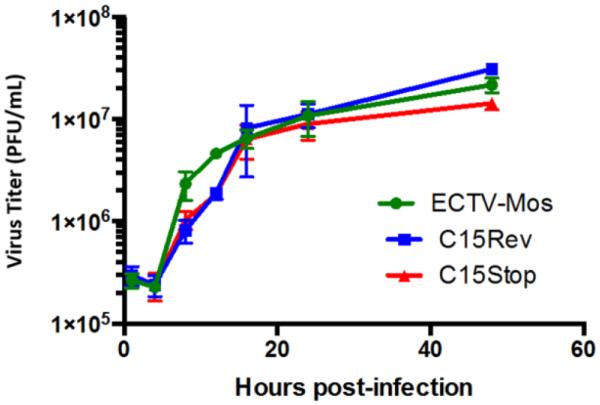
Replication of C15Rev and C15Stop in cell culture. Mouse L929 cells were mock infected or infected with 3 PFU per cell of the Moscow strain of ECTV (ECTV-Mos) or the C15Rev or C15Stop derivatives. Cells and media were harvested together at various times post infection and virus titers determined by plaque assays on BS-C-1 cells. Infections were done in triplicate and standard deviations shown by error bars.
2.2. Lethality of footpad infection of BALB/c mice
Footpad inoculation causes severe disease in susceptible mice and is considered to be a route of ECTV infection that closely mimics natural spread (Fenner, 1948d). To determine whether C15 expression influences the pathogenicity of ECTV, we infected BALB/c mice in the hind footpad with C15Rev or C15Stop at doses ranging from 10 to 1,000 PFU per mouse. Following footpad infection, deaths occurred primarily between days 9 and 12 with a few animals succumbing to the disease as late as day 18. No matter the viral dosage, infection with C15Stop resulted in fewer deaths than with C15Rev (Fig. 2) and the difference in survival time was significant at the 100 and 1,000 PFU doses (p<0.01, log rank Mantel-Cox method). Paradoxically, some mice died after 10 or 100 PFU of C15Stop but not 1,000 PFU and the difference in survival time was significant between the 100 and 1,000 PFU doses (p=0.01) but not between the 10 and 100 PFU doses. The survival with high doses of C15Stop was observed over multiple experiments and all mice survived even with 20,000 PFU of C15Stop per mouse (data not shown). The mean survival time of animals infected with 10, 100 and 1,000 PFU of C15Rev was 12, 9 and 10.5 days. The difference in survival time was significant between the 10 and 100 PFU doses (p=0.006) but not between the 100 and 1,000 PFU doses. Thus, survival of mice was enhanced by deletion of C15.
Fig. 2.
Absence of C15 expression reduces mortality after ECTV footpad infection. Female 8-week old BALB/c mice were injected in the left hind footpad with 10 μl of C15Rev or C15Stop virus at doses of 10, 100 or 1,000 PFU per mouse. Shown are the combined results of two independent experiments each with five animals per dose. Endpoints were determined by natural death or in 3 cases by euthanasia.
Animals were scored for disease based on their movement and the conditions of the coat, eyes and limb. The highest total scores at any time attained by mice infected with 1,000 PFU of C15Rev or C15-Stop are shown in Fig. 3A. Overall, these scores did not correlate well with outcome partly because of the varied times of death. Some animals died early with low scores while others survived longer and attained higher scores. The high scores of animals that were infected with 1,000 PFU/mouse of C15Stop and survived were similar to those of animals that were infected with C15Rev and succumbed.
Fig. 3.
Effect of virus dose on disease symptoms. (A) Animals from Fig. 2 were scored for disease symptoms daily following infection. Movement and condition of the coat, eyes and limb each contributed to the scores. The highest total score achieved at any time during disease course by each animal was plotted with those animals who survived shown in black; animals that subsequently died or were euthanized are shown in purple and green, respectively. The bars represent the mean score and one standard deviation above and below. (B) Animals mock-infected or infected with 1,000 PFU of C15Stop or C15Rev were from the experiments used in Fig. 2. Footpad swelling was determined twice weekly by measuring the width and height of swelling and the size was calculated by multiplying these values. On day 13 only three C15Rev animals remained and on day 18 only one C15Rev animal remained. All five C15Stop animals survived. Bars represent the median values. On day 10 swelling was significantly (Mann-Whitney, *p = 0.0127) greater in the C15Stop animals than in C15Rev animals.
Swelling of the infected foot occurred in most mice between days 5 and 7 and increased for several more days in surviving animals (Fig. 3B). On day 10, the mean foot size increased from 8.6 mm2 for mock-infected animals to 14, 19, and 22 mm2 for animals infected with 10, 100, and 1,000 PFU of C15Stop, respectively and to 12, 14, and 17 mm2 for animals infected with C15Rev. However, there was a great deal of individual variation and the difference between C15Rev and C15Stop was only significant at the 1,000 PFU dose (p=0.01). At later times, there were too few surviving animals infected with C15Rev for meaningful comparison.
2.3. Decreased virus dissemination in mice infected with C15Stop
To determine the basis for the greater mortality in mice infected with C15Rev than with C15Stop we examined tissues known to be key in the spread and pathogenesis of ECTV: the foot (site of infection), the draining popliteal and inguinal lymph nodes, spleen and liver. Twenty animals were infected with 1,000 PFU of C15Rev or C15Stop and 5 were sacrificed at each of 2, 4, 6 and 8 days post-infection. Tissues were homogenized and virus titers determined. The titers in the foot increased from day 2 to day 8 but were similar to each other in mice infected with C15Rev and C15Stop indicating that differences in mortality were not due to differences in replication at the site of infection (Fig. 4A). At day 2 only one C15Stop infected animal had a measurable virus titer in the popliteal node, the most proximal lymph node to the site of infection that was analyzed, whereas all mice infected with C15Rev had detectable titers. By day 4, C15Stop virus was detected in the popliteal nodes of all animals though the mean and median titers were lower than in C15Rev-infected mice. Furthermore, on days 6 and 8 the virus titers of C15Stop animals in the popliteal lymph node were less than C15Rev by approximately one log (p < 0.01, p < 0.05, respectively) (Fig. 4B). Infection of the inguinal lymph node was delayed compared to the popliteal but the trend was similar: virus titers were detectable in two of five C15Rev infected animals on day 4 but not in C15Stop animals, followed by less in the C15Stop animals on days 6 and 8 (p < 0.01). Two animals infected with C15Stop still had no detectable virus in the inguinal lymph nodes on days 6 and 8, whereas C15Rev-infected animals had titers as high as 106 PFU/organ on day 8 (Fig. 4C).
Fig. 4.
Absence of C15 reduces virus load. Female 8-week old BALB/c mice were infected in the footpad with 1,000 PFU of C15Rev or C15Stop and tissues were collected on days 2, 4, 6 and 8. Tissues were homogenized and virus was titered on BS-C-1 cells. Foot, spleen and liver are shown as PFU/gram of tissue and lymph nodes as PFU/organ. Bars show median titers. Significant differences by Mann-Whitney are shown, p < 0.05 (*) or p < 0.01 (**). Plasma from infected animals was collected, DNA was purified and genome copy number was determined through the use of digital droplet PCR. Genomes are reported in copy number per μl of plasma. (p = 0.095).
High virus loads in the spleen and liver are associated with death due to ECTV (Jacoby and Bhatt, 1987b; Wallace and Buller, 1985). Following infection we detected virus in the spleen of C15Rev- and C15Stop-infected animals in similar amounts on day 4; however, on days 6 and 8 there was less virus in the spleens of C15Stop-infected animals (p < 0.05, p < 0.01, respectively) (Fig. 4D). In the liver the difference between the virus titers of animals infected with C15Stop and C15Rev was between four and five logs on day 8 (p < 0.01) (Fig 4E). The number of viral genomes in the plasma was determined by droplet digital PCR. There was a trend for more viral genomes in animals infected with C15Rev than C15Stop (p=0.095) (Fig 4F). The differences in virus loads in organs of animals infected with C15Stop and C15Rev indicated better control of the spread and/or replication of ECTV in the absence of the C15 protein.
The high virus dose of 1,000 PFU showed the greatest difference in mortality between C15Rev and C15Stop, but also an unusual phenomenon whereby animals infected with lower doses of C15Stop had greater mortality than with higher doses (Fig. 2). To investigate this further we determined virus titers on day 8 from animals that received 10, 100 or 1,000 PFU. Although the virus titers from the foot increased significantly with virus dose, they were similar for mice infected with C15Rev and C15Stop (Fig. 5A). In contrast, the titers in the popliteal and inguinal lymph nodes decreased with increasing dose of C15Stop but were similar or increased with C15Rev (Fig. 5B, C). The amounts of virus in the spleens and livers of mice infected with C15Rev increased with dose whereas the amounts were lower and changed little or decreased with C15Stop (Fig. 5D, E). Overall, the results indicated that the decreased mortalities at high virus inocula were associated with decreased spread of C15Stop to the lymph nodes and internal organs.
Fig. 5.
Effect on inoculum size on virus load in tissues. Female 8-week old BALB/c mice were infected in the footpad with 10, 100 or 1,000 PFU of C15Rev or C15Stop and organ tissues were collected on day 8. Tissues were homogenized and virus titered on BS-C-1 cells. Foot, spleen and liver are shown as PFU/gram of tissue. Lymph nodes are PFU/organ. Bars show median titers. Statistics were performed using the Kruskal-Wallis (nonparametric) method with Dunn's multiple comparison correction. *p<0.05 **p<0.01.
2.4. Histological analysis of tissues
On each of days 2, 4 and 6, tissues from three mice mock infected or infected with 1,000 PFU of C15Rev or C15Stop were collected and examined histologically by staining with hemotoxylin eosin (H&E) and immunohistochemically (IHC) by using antibody to VACV that cross-reacts with ECTV. Figure 6 shows representative images of the histochemical and immunohistochemical changes in the popliteal lymph nodes on day 4 and inguinal lymph nodes, spleen and liver on day 6. On day 4 the popliteal node of animals infected with C15Rev showed histochemical evidence of severe and diffuse lymphoid necrosis and immunohistochemistry showed extensive dissemination of virus antigen. In contrast, the lymph node from mice infected with C15Stop, rarely showed changes consistent with degeneration or necrosis on H&E evaluation and a far smaller amount of virus antigen present along the periphery of the tissue following evaluation by IHC. Similar patterns of tissue disruption and virus antigen distribution were evident in the inguinal node on day 6. In addition to the changes in the lymph nodes, the spleen showed numerous, large areas of tissue degeneration and necrosis, accompanied by abundant virus antigen following infection with C15Rev virus; the tissue changes were less severe and antigen less abundant following infection with the C15Stop virus. The liver was the least severely affected of the tissues examined on day 6, although foci of hepatocellular necrosis and virus antigen were more abundant following infection with C15Rev virus compared to the C15Stop virus. Thus, at each time point, the histological and immunohistochemical changes observed following C15Rev virus infection were more severe and more widespread than those of animals infected with the C15Stop virus. These findings were consistent with the data on virus loads of the animals infected with C15Rev and C15Stop.
Fig. 6.
Histological examination. Female BALB/c mice (n=3 per group) were infected in the footpad with PBS (mock) or 1000 PFU of C15Rev or C15Stop and sacrificed on days 2, 4, and 6 post-infection. Harvested tissues were fixed with formalin, embedded in paraffin, stained with hematoxylin and eosin (H&E) or with a polyclonal anti-VACV antibody for immunohistochemistry (IHC) and examined via light microscopy. Images representative of the popliteal lymph node on day 4 post-infection and inguinal lymph node, spleen and liver on day 6 post-infection are shown.
2.5. T cells are required for survival of mice following infection with C15Stop
We considered two general mechanisms to account for the attenuation of C15Stop virus. One is that C15 membrane protein directly enhances dissemination of ECTV and the other is that C15 inhibits the host response to ECTV. If the former were true, then C15Stop might still be attenuated even if CD4+ or CD8+ T cells were depleted. Depletion was achieved with CD4− and CD8-specific mouse MAbs administered by intraperitoneal injection prior to infection. A non-targeting antibody of the same isotype was used as a control. At the time of infection, the extent of depletion of CD4 and CD8 cells was demonstrated in an independent experiment to be over 99% (data not shown). The footpads of 5 mice were inoculated with 1,000 PFU of C15Rev or C15Stop virus in each of two separate experiments. 70% of mice that received the control isotype MAb succumbed to C15Rev, but only one animal infected with C15Stop died very late after infection on day 23 (Fig. 7). In contrast, depletion of either or both CD4+ and CD8+ T cells resulted in 100% mortality of animals infected with C15Stop or C15Rev virus on days 8 or 9 (Fig. 7). The differences in mean survival times between the animals treated with isotype control antibodies and those depleted of either or both CD4 or CD8 cells were significant (p≤0.001, log rank Mantel-Cox calculation) whether infected with C15Rev or C15Stop. In contrast, the differences between the depletion of CD4 or CD8 or the combination were insignificant as was the difference between T cell depleted animals infected with C15Rev and C15Stop. Thus, the decreased virulence of C15Stop was dependent on a functioning immune system.
Fig. 7.
Effects of depletion of CD4+ and/or CD8+ T cells on survival. Female 8-week old mice were injected intraperitoneally with isotype control antibody, anti-CD4, and/or anti-CD8 antibody at three and five days prior to infection. Infections were performed by injecting the left hind footpad with 10 μl of 1,000 PFU of C15Rev or C15Stop. Endpoints were determined by natural death or in a few cases by euthanasia. Data are combined from two independent experiments each with five animals per group.
3. Discussion
The replicative ability of VACV, which lacks a B22 homolog, as well as CPXV (Reynolds and Moss, 2015) and MPXV (Alzhanova et al., 2014) mutants had suggested that the protein is not required for an intrinsic viral function and likely has a role in obstructing host defense. Moreover, the presence of B22 proteins in most poxviruses implies that the host function has been conserved in fish, reptiles, birds and mammals. Nevertheless, deletion of the CPXV homolog did not attenuate pathogenicity for mice, which are not natural hosts of CPXV (Reynolds and Moss, 2015). The latter result fit with the finding that B22 orthologs exhibit host specificity for inhibition of T cell activation and more specifically that the CPXV homolog does not inhibit murine T cells (Alzhanova et al., 2014). Taken together, these results encouraged us to determine whether the absence of the B22 homolog would attenuate pathogenicity of a poxvirus in a natural host e.g. footpad infection of mice by ECTV (Fenner, 1948d).
As expected from previous studies with CPXV and MPXV, the absence of C15 expression did not affect the replication of ECTV in cultured mouse cells and the particle to PFU ratios of control and mutant viruses were similar. However, greater mortality occurred at all doses tested when control virus was injected in the footpads of BALB/c mice compared to the C15 mutant. Unexpectedly, however, mortality did not directly correlate with dose of the C15 mutant; at 1,000 PFU or more there was less mortality than at doses of 10 to 100 PFU. To follow the course of infection, we determined the virus loads over time in the feet, popliteal and inguinal lymph nodes, liver and spleen. At the 1,000 PFU dose, in which most C15Rev mice died and C15Stop mice survived, the titers of both viruses increased to the same extent in the foot indicating similar replication at the site of infection. However, there was significantly less C15Stop virus in the lymph nodes and internal organs compared to C15Rev accounting for the reduced mortality. For C15Rev the virus titers in the foot and other tissues generally increased with virus dose. The virus titers also increased with dose in the foot following infection with C15Stop; however, the titers did not increase and generally decreased with dose in other tissues. Taking the data on mortality and virus titers together, the attenuation of C15Stop appears to be due to decreased spread from the foot to the lymph nodes and beyond. Furthermore, the above data were complimented by the pathological changes observed in the tissues. ECTV-associated destruction of vital organs (liver and spleen) and subsequent death has been well documented (Jacoby and Bhatt, 1987a) and in this study those animals infected with the C15Rev virus showed greater severity of tissue pathology and more virus antigen, compared to the animals that were administered the C15Stop virus. In particular, we observed substantial differences in the ability of virus spread, demonstrated by the massive necrosis and abundant virus antigen observed in the popliteal lymph node (most proximal to the site of infection) and beyond (inguinal lymph node) following infection with the C15Rev compared to the milder pathology and smaller amount of virus antigen observed with C15Stop.
Since the B22 homologs localize to the plasma membrane, it seemed possible that the protein might enhance virus spread directly in animals. Alternatively, the protein may only be involved in immune defense. Such a role was suggested by inhibition of T cell activation in the MPXV model (Alzhanova et al., 2014). If the role of the C15 protein is to prevent T cell activation, then one might expect the virulence of C15Rev and C15Stop to be more similar to each other if T cells were depleted. On the other hand, if the major role of C15 is to enhance virus spread directly, then there might still be low virulence of C15Stop after T cell depletion. We found that the mortality increased to 100% when either CD4+ or CD8+ T cells were depleted, indicating that T cells provide important protection against C15Stop and C15Rev. Although it remains to be directly demonstrated, a greater T cell response could explain the reduced spread and mortality of C15Stop compared to C15Rev. Along the same lines, the local innate immune or inflammatory response might develop more rapidly with higher doses of C15Stop thereby reducing spread from the foot to the lymph nodes or preventing virus replication there leading to the paradoxical effect of virus dose and survival.
The present study highlights the importance of matching virus with a natural host when studying the potential role of a viral immune modulator. Nevertheless, further studies are needed to determine why the B22 homolog enhances virulence of ECTV but not CPXV. The most interesting possibility is that the ECTV homolog is better adapted to interact with the mouse immune system, even though they are 92% identical in amino acid sequence. Alternatively, the difference may be due to viral genome backgrounds e.g. CPXV has more host defense genes than other orthopoxviruses and there may be redundancy with regard to the function of the B22 homolog. Still a third possibility is the route of infection, which was intranasal in the CPXV study and footpad in the present. Studies in which the B22 homologs of ECTV and CPXV are switched between the mouse strains might help to differentiate these possibilities.
4. Materials and Methods
4.1 Cells
BS-C-1 cells were maintained at 37°C and 5% CO2 in modified Eagle minimal essential medium (EMEM, Quality Biologicals, Inc., Gaithersburg, MD) supplemented with 10% fetal bovine serum, 2 mM L-glutamine, 10 U of penicillin/ml, and 10 mg of streptomycin/ml. HeLa and L929 cells were propagated in Dulbecco's modified Eagle's medium supplemented with 10% fetal bovine serum and antibiotics as described above.
4.2 ECTV
The Moscow strain of ECTV was obtained from ATCC (VR-1374). Following limited passage, a clonal isolate was derived and shown to replicate equivalently to the uncloned parental virus in tissue culture, and to have similar pathogenicity via footpad infection (data not shown). Virus was purified as previously described (Cotter et al., 2015). Briefly, BS-C-1 cells infected with 1 PFU/cell for 48 to 72 h were Dounce homogenized, and purified through a 36% sucrose cushion. The pellet was suspended in 1 mM Tris-HCl for use in animal experiments. All viruses were tested for bacterial contamination by removing a small volume, inoculating in LB broth at 37°C with shaking, and observing for turbidity. All virus preparations were negative.
4.3. Generation of recombinant viruses
Recombinant viruses were constructed from the ECTV-Mos clonal isolate. Overlapping PCR was used to generate DNA sequences for homologous recombination as previously described (Reynolds and Moss, 2015). In short, the GFP open reading frame regulated by a VACV promoter or the unmodified or modified C15 open reading frame containing two premature stop codons were flanked by the DNA sequences at the site of insertion. To create the stop sequences the following primers were used with changes shown in bold: SR169.C15-R Stop 5'- GTA AGC TAT ATA GCC AGA GAT TAT TTC TGT AAA TTC ATG ATT G -3' and SR170.C15-F Stop 5'- CAA TCA TGA ATT TAC AGA AAT AAT CTC TGG CTA TAT AGC TTA C -3'. The ECTV-C15GFP was created by transfecting C15GFP DNA with Lipofectamine 2000 (Invitrogen) into HeLa cells followed 1 h later by infection with ECTV-Mos. After 5 – 7 days incubation under 5% Methylcellulose-EMEM, virus was isolated from fluorescent plaques and then re-plaqued to clonal homogeneity. A similar procedure was used to derive C15Rev and C15Stop except that the ECTV-C15GFP was used as the parental virus and virus was obtained from non-fluorescent plaques. The recombinant DNA sequences for each virus were verified by PCR and sequencing. Viruses were propagated in BS-C-1 cells and released through three repeated freeze/thaw cycles. Samples were sonicated prior to each use and virus titers were determined in duplicate using BS-C-1 cells.
4.4. Kinetics of virus growth in tissue culture
Mouse L929 cells were infected in triplicate with 3 PFU/cell at 37°C in EMEM for 1 h, washed three times with fresh, warm EMEM to remove the inoculum, and incubated at 37°C. Cells and media were harvested at appropriate times post-infection, frozen and thawed three times and sonicated prior to titration on BS-C-1 cells. The cell monolayers were overlaid with 5% Methylcellulose-EMEM for 6 days and stained with 2% crystal violet.
4.5. Mice
All experimental procedures involving mice were approved by the National Institutes of Allergy and Infectious Disease Animal Care and Use Committee and carried out in a humane manner. Female BALB/c mice were obtained from Taconic Biotechnology (Germantown, NY). Mice were maintained in a clean environment in small, static filter-top microisolator cages within an isolated room of an animal biosafety level 3 suite in accordance with protocols approved by NIAID Animal Care and Use committee. The virus inoculum was sonicated and diluted in phosphate buffered saline + 0.05% bovine serum albumin and a sample was saved to confirm dosage by plaque assay. Groups of 5 female BALB/c mice 7 to 8 weeks old were sedated with isoflurane. A 25–27 gauge needle attached to a 25 μl gastight syringe (Hamilton) was inserted into the left hind footpad in the middle of the walking pads 8 to 10 mm beneath the skin. Mice were monitored daily and euthanized if they were determined to be moribund in accordance with NIAID Animal Care and Use protocols.
4.6 Evaluation of disease and virus spread
To monitor the progression of disease, animals were observed daily and given a score ranging from 0 (healthy) to 3 (severely ill) for each of the following categories: coat condition, movement/activity, eye condition, and limb swelling/necrosis as described (Melo-Silva et al., 2011). Veterinarians or technicians independently observed animals and euthanized them when manifestations were extremely severe in one or more disease parameters. Foot measurements were performed using digital calipers to measure the thickest part of the foot and width at the base of the toes. The area of swelling was calculated by multiplying these measurements.
Blood was collected from the mandibular vein in polypropylene tubes with EDTA and processed by centrifugation at 2,000 × g for 8 min to pellet cells; the plasma was aliquoted and stored at −80°C. Animals were necropsied immediately after sacrifice and organs were collected including the inguinal and popliteal lymph nodes on the left side, the left hind foot, spleen and all lobes of the liver. Organs were placed in 1 to 2 ml of balanced salt solution with 0.1% bovine serum albumin and stored at −80°C until use. Lymph nodes were Dounce homogenized and, other organs were homogenized with a GLH-1 mechanical grinder equipped with hard-tissue disposable probes and aerosol-proof caps (Omni International, Kennesaw, GA). After sonication, the homogenates were centrifuged for 10 s at 400 × g to remove cellular debris. Supernatants were aliquoted into fresh tubes and either frozen or used for virus titration by plaque assay on BS-C-1 cells.
Viral DNA was extracted using the QIAamp MinElute Virus Spin Kit (Qiagen) according to the manufacturer's protocol and stored at −20 °C. Genome copy number was determined by droplet digital PCR (BioRad). Briefly, viral extracts from the MinElute spin kit were placed in a PCR plate with Evagreen supermix and primers targeting the E11 protein. Primer sequences were as follows: PXV(E11L)#2Rev_JA 5' – GGT TCG TCA AAG ACA TAA AAC TCA TT - 3' and PXV(E11L)#3For_JA 5' – GAA TAC ATT CAC ATT GAC CAA TCA GAA – 3' Droplets were created in the automatic droplet generator, and genomes were amplified by PCR. Droplets were read in the BioRad QX200 droplet reader and analysis was performed using the Quantasoft software.
4.7 Histological analysis of tissues of mice infected with ECTV
Groups of three BALB/c mice were infected in the left footpad with 1000 PFU of C15Rev or C15Stop and sacrificed on days 2, 4 and 6 post-infection. Tissues from mock-infected (control) animals were collected on days 4 and 6. The tissue sections including the left popliteal lymph node, left inguinal lymph node, spleen, and liver were fixed with 10% neutral buffered formalin, embedded in paraffin, and stained with H&E for routine histopathology and examination by light microscopy. IHC staining was performed using an anti-VACV rabbit polyclonal antibody (1:2,000 dilution). Staining was performed on the Bond RX (Leica Biosystems) platform according to manufacturer-supplied protocols. Briefly, 5 μm-thick sections were deparaffinized and rehydrated. Heat-induced epitope retrieval was performed using Epitope Retrieval Solution 1 (Leica biosystems CAT# AR9961), pH 6.0, heated to 100°C for 20 min. Tissue specimens were then incubated with hydrogen peroxide to quench endogenous peroxidase activity prior to applying the primary antibody. Detection with 3,3'-diaminobenzidine chromogen was completed using the Bond Polymer Refine Detection kit (Leica Biosystems CAT# DS9800). Slides were finally cleared through gradient alcohol and xylene washes prior to mounting and coverslipping. Sections were examined using an Olympus BX51 microscope and photomicrographs were taken using an Olympus DP73 camera.
4.8. T cell depletion
MAbs against CD4 (clone GK1.5), CD8 (clone YTS 169.4), or KLH (isotype control, clone LTF-2)(Bio X Cell, Lebanon, NH) were utilized for T cell depletion. Mice were injected intraperitoneally with 0.2 mg of MAb in 200 μl of PBS on days 3 and 4 before virus challenge. The efficacy of depletion was tested in an independent experiment by flow cytometry of cells harvested from whole blood on days 5 and 13 and spleen when terminated on day 29.
Highlights.
The C15 membrane protein of ectromelia virus is 91% identical to variola virus B22
C15 expression is not required for replication of ectromelia virus in mouse cells
Ectromelia virus C15 null mutant is attenuated in the mouse foot pad model
Survival of infected mice is dependent on CD4+ and CD8+ T cells
Acknowledgements
We thank Catherine Cotter for assistance with tissue culture and Jeffrey Americo for help with digital PCR. The Comparative Medicine Branch provided animal care including daily weight measurements. The research was supported by the Division of Intramural Research, NIAID, NIH. S.R. carried out research while a Ph.D. candidate in the Department of Cell Biology and Molecular Genetics at the University of Maryland, College Park, MD.
Footnotes
Publisher's Disclaimer: This is a PDF file of an unedited manuscript that has been accepted for publication. As a service to our customers we are providing this early version of the manuscript. The manuscript will undergo copyediting, typesetting, and review of the resulting proof before it is published in its final citable form. Please note that during the production process errors may be discovered which could affect the content, and all legal disclaimers that apply to the journal pertain.
References
- Alzhanova D, Hammarlund E, Reed J, Meermeier E, Rawlings S, Ray CA, Edwards DM, Bimber B, Legasse A, Planer S, Sprague J, Axthelm MK, Pickup DJ, Lewinsohn DM, Gold MC, Wong SW, Sacha JB, Slifka MK, Fruh K. T cell inactivation by poxviral B22 family proteins increases viral virulence. PLoS Pathog. 2014;10:e1004123. doi: 10.1371/journal.ppat.1004123. [DOI] [PMC free article] [PubMed] [Google Scholar]
- Buller RM, Owens G, Schriewer J, Melman L, Beadle JR, Hostetler KY. Efficacy of oral active ether lipid analogs of cidofovir in a lethal mousepox model. Virology. 2004;318:474–481. doi: 10.1016/j.virol.2003.11.015. [DOI] [PubMed] [Google Scholar]
- Chaudhri G, Panchanathan V, Buller RM, van den Eertwegh AJ, Claassen E, Zhou J, de Chazal R, Laman JD, Karupiah G. Polarized type 1 cytokine response and cell-mediated immunity determine genetic resistance to mousepox. Proc Natl Acad Sci U S A. 2004;101:9057–9062. doi: 10.1073/pnas.0402949101. [DOI] [PMC free article] [PubMed] [Google Scholar]
- Cotter CA, Earl PL, Wyatt LS, Moss B. Preparation of Cell Cultures and Vaccinia Virus Stocks. Curr Protoc Microbiol. 2015;39:13, 11–18. doi: 10.1002/9780471729259.mc14a03s39. 14A. [DOI] [PMC free article] [PubMed] [Google Scholar]
- Damon I. Poxviruses. In: Knipe DM, Howley PM, editors. Fields Virology. Sixth ed Wolters Kluwer/ Lippincott Williams &Wilkins; Philadelphia: 2013. pp. 2160–2184. [Google Scholar]
- Esteban DJ, Buller RM. Ectromelia virus: the causative agent of mousepox. J Gen Virol. 2005;86:2645–2659. doi: 10.1099/vir.0.81090-0. [DOI] [PubMed] [Google Scholar]
- Fenner F. The pathogenesis of the acute exanthems; an interpretation based on experimental investigations with mousepox; infectious ectromelia of mice. Lancet. 1948d;2:915–920. doi: 10.1016/s0140-6736(48)91599-2. [DOI] [PubMed] [Google Scholar]
- Fenner F. Studies in mousepox, infectious ectromelia of mice; quantitative investigations on the spread of virus through the host in actively and passively immunized animals. Aust J Exp Biol Med Sci. 1949b;27:1–18. [PubMed] [Google Scholar]
- Gjessing MC, Yutin N, Tengs T, Senkevich T, Koonin E, Ronning HP, Alarcon M, Ylving S, Lie KI, Saure B, Tran L, Moss B, Dale OB. Salmon Gill Poxvirus, the Deepest Representative of the Chordopoxvirinae. J Virol. 2015;89:9348–9367. doi: 10.1128/JVI.01174-15. [DOI] [PMC free article] [PubMed] [Google Scholar]
- Jacoby RO, Bhatt PN. Mousepox in inbred mice innately resistant or susceptible to lethal infection with ectromelia virus. II. Pathogenesis. Lab. Anim. Sci. 1987a;37:16–22. [PubMed] [Google Scholar]
- Jacoby RO, Bhatt PN. Mousepox in inbred mice innately resistant or susceptible to lethal infection with ectromelia virus. II. Pathogenesis. Lab Anim Sci. 1987b;37:16–22. [PubMed] [Google Scholar]
- Marchal J. Infectious Ectromelia. A Hitherto Undescribed Virus Disease of Mice. J. of Path. & Bact. 1930;33:713–728. [Google Scholar]
- Melo-Silva CR, Tscharke DC, Lobigs M, Koskinen A, Wong YC, Buller RM, Mullbacher A, Regner M. The Ectromelia Virus SPI-2 Protein Causes Lethal Mousepox by Preventing NK Cell Responses. J. Virol. 2011;85:11170–11182. doi: 10.1128/JVI.00256-11. [DOI] [PMC free article] [PubMed] [Google Scholar]
- Moss B. Poxvirus DNA replication. Cold Spring Harb Perspect Biol. 2013;5 doi: 10.1101/cshperspect.a010199. [DOI] [PMC free article] [PubMed] [Google Scholar]
- Pauli G, Blumel J, Burger R, Drosten C, Groner A, Gurtler L, Heiden M, Hildebrandt M, Jansen B, Montag-Lessing T, Offergeld R, Seitz R, Schlenkrich U, Schottstedt V, Strobel J, Willkommen H, von Konig CH. Orthopox Viruses: Infections in Humans. Transfus Med Hemother. 2010;37:351–364. doi: 10.1159/000322101. [DOI] [PMC free article] [PubMed] [Google Scholar]
- Reynolds SE, Moss B. Characterization of a large, proteolytically processed cowpox virus membrane glycoprotein conserved in most chordopoxviruses. Virology. 2015;483:209–217. doi: 10.1016/j.virol.2015.04.014. [DOI] [PMC free article] [PubMed] [Google Scholar]
- Schriewer J, Buller RM, Owens G. Mouse models for studying orthopoxvirus respiratory infections. Methods Mol Biol. 2004;269:289–308. doi: 10.1385/1-59259-789-0:289. [DOI] [PubMed] [Google Scholar]
- Smith GL, Benfield CT, Maluquer de Motes C, Mazzon M, Ember SW, Ferguson BJ, Sumner RP. Vaccinia virus immune evasion: mechanisms, virulence and immunogenicity. J Gen Virol. 2013;94:2367–2392. doi: 10.1099/vir.0.055921-0. [DOI] [PubMed] [Google Scholar]
- Wallace GD, Buller RM. Kinetics of ectromelia virus (mousepox) transmission and clinical response in C57BL/6j, BALB/cByj and AKR/J inbred mice. Laboratory animal science. 1985;35:41–46. [PubMed] [Google Scholar]



